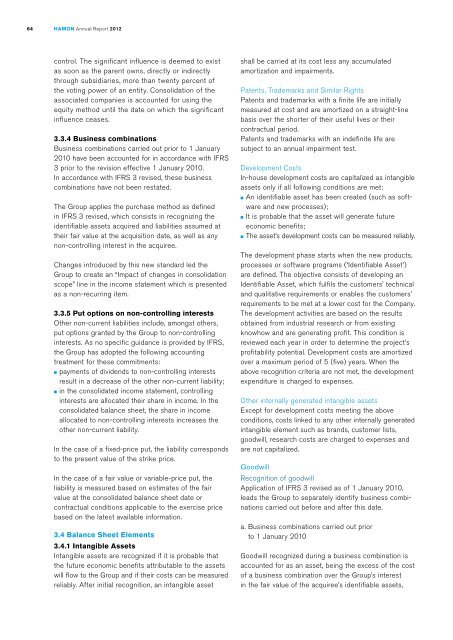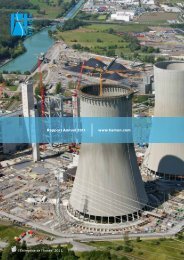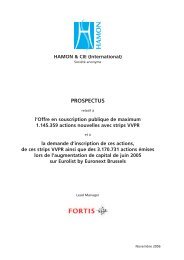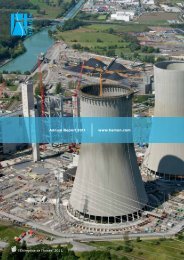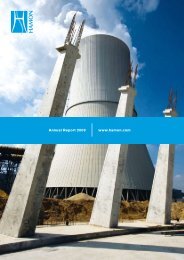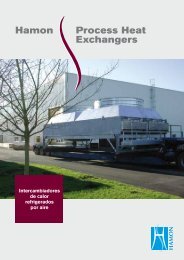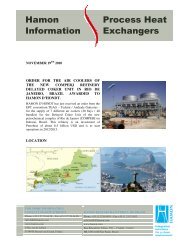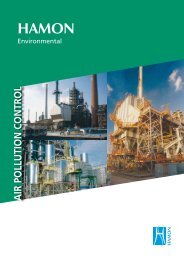Download PDF version English (3237KB) - Hamon
Download PDF version English (3237KB) - Hamon
Download PDF version English (3237KB) - Hamon
Create successful ePaper yourself
Turn your PDF publications into a flip-book with our unique Google optimized e-Paper software.
64<br />
<strong>Hamon</strong> Annual Report 2012<br />
control. The significant influence is deemed to exist<br />
as soon as the parent owns, directly or indirectly<br />
through subsidiaries, more than twenty percent of<br />
the voting power of an entity. Consolidation of the<br />
associated companies is accounted for using the<br />
equity method until the date on which the significant<br />
influence ceases.<br />
3.3.4 Business combinations<br />
Business combinations carried out prior to 1 January<br />
2010 have been accounted for in accordance with IFRS<br />
3 prior to the revision effective 1 January 2010.<br />
In accordance with IFRS 3 revised, these business<br />
combinations have not been restated.<br />
The Group applies the purchase method as defined<br />
in IFRS 3 revised, which consists in recognizing the<br />
identifiable assets acquired and liabilities assumed at<br />
their fair value at the acquisition date, as well as any<br />
non-controlling interest in the acquiree.<br />
Changes introduced by this new standard led the<br />
Group to create an “Impact of changes in consolidation<br />
scope” line in the income statement which is presented<br />
as a non-recurring item.<br />
3.3.5 Put options on non-controlling interests<br />
Other non-current liabilities include, amongst others,<br />
put options granted by the Group to non-controlling<br />
interests. As no specific guidance is provided by IFRS,<br />
the Group has adopted the following accounting<br />
treatment for these commitments:<br />
■ payments of dividends to non-controlling interests<br />
result in a decrease of the other non-current liability;<br />
■ in the consolidated income statement, controlling<br />
interests are allocated their share in income. In the<br />
consolidated balance sheet, the share in income<br />
allocated to non-controlling interests increases the<br />
other non-current liability.<br />
In the case of a fixed-price put, the liability corresponds<br />
to the present value of the strike price.<br />
In the case of a fair value or variable-price put, the<br />
liability is measured based on estimates of the fair<br />
value at the consolidated balance sheet date or<br />
contractual conditions applicable to the exercise price<br />
based on the latest available information.<br />
3.4 Balance Sheet Elements<br />
3.4.1 Intangible Assets<br />
Intangible assets are recognized if it is probable that<br />
the future economic benefits attributable to the assets<br />
will flow to the Group and if their costs can be measured<br />
reliably. After initial recognition, an intangible asset<br />
shall be carried at its cost less any accumulated<br />
amortization and impairments.<br />
Patents, Trademarks and Similar Rights<br />
Patents and trademarks with a finite life are initially<br />
measured at cost and are amortized on a straight-line<br />
basis over the shorter of their useful lives or their<br />
contractual period.<br />
Patents and trademarks with an indefinite life are<br />
subject to an annual impairment test.<br />
Development Costs<br />
In-house development costs are capitalized as intangible<br />
assets only if all following conditions are met:<br />
■ An identifiable asset has been created (such as software<br />
and new processes);<br />
■ It is probable that the asset will generate future<br />
economic benefits;<br />
■ The asset’s development costs can be measured reliably.<br />
The development phase starts when the new products,<br />
processes or software programs (‘Identifiable Asset’)<br />
are defined. The objective consists of developing an<br />
Identifiable Asset, which fulfils the customers’ technical<br />
and qualitative requirements or enables the customers’<br />
requirements to be met at a lower cost for the Company.<br />
The development activities are based on the results<br />
obtained from industrial research or from existing<br />
knowhow and are generating profit. This condition is<br />
reviewed each year in order to determine the project’s<br />
profitability potential. Development costs are amortized<br />
over a maximum period of 5 (five) years. When the<br />
above recognition criteria are not met, the development<br />
expenditure is charged to expenses.<br />
Other internally generated intangible assets<br />
Except for development costs meeting the above<br />
conditions, costs linked to any other internally generated<br />
intangible element such as brands, customer lists,<br />
goodwill, research costs are charged to expenses and<br />
are not capitalized.<br />
Goodwill<br />
Recognition of goodwill<br />
Application of IFRS 3 revised as of 1 January 2010,<br />
leads the Group to separately identify business combinations<br />
carried out before and after this date.<br />
a. Business combinations carried out prior<br />
to 1 January 2010<br />
Goodwill recognized during a business combination is<br />
accounted for as an asset, being the excess of the cost<br />
of a business combination over the Group’s interest<br />
in the fair value of the acquiree’s identifiable assets,


